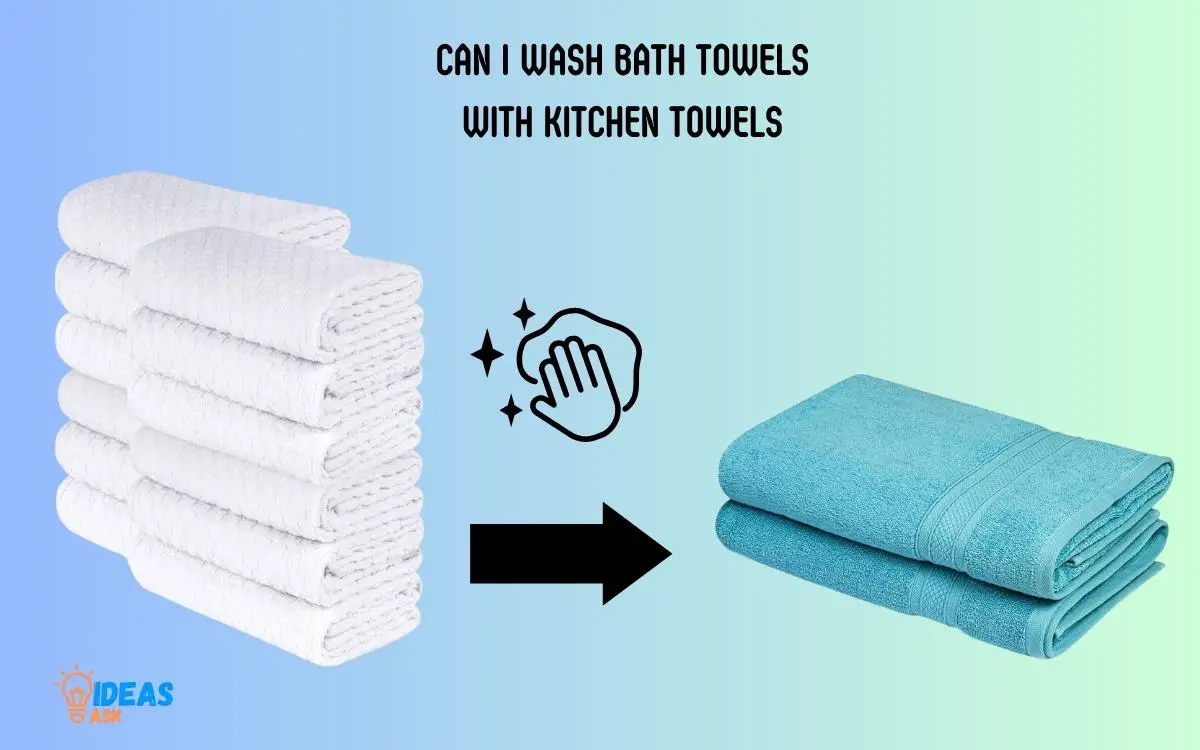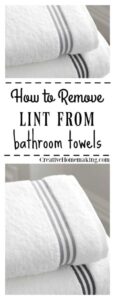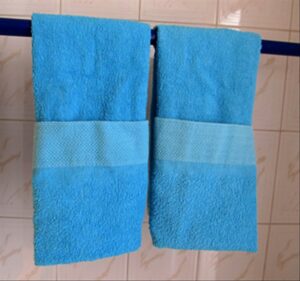Can I Wash Bath Towels With Kitchen Towels? Yes!
Yes, you can wash bath towels with kitchen towels. However, keep in mind the potential for cross-contamination.
While both bath towels and kitchen towels share the same basic function of absorbing moisture, they are used in different environments and for various purposes.
Bath towels typically come in contact with body oils and dead skin, while kitchen towels may be used to wipe down surfaces, dry hands, and clean up food spills.
For these reasons, potential for bacterial cross-contamination exists. However, if washed properly using hot water and good quality detergent, this risk can be minimized.
Cleaning these towels properly and regularly not only keeps them fresh and ready-to-use but also helps to maintain a healthy environment in your home.

Key Takeaway
Understanding Bath Towels And Kitchen Towels
Bath towels and kitchen towels may seem similar at first glance, but they serve different purposes and possess distinct characteristics.
Let’s delve into the intricacies of these two types of towels to understand why they shouldn’t be mixed when it comes to daily use and washing routines.
Discussion On The Purpose And Design Of Bath Towels
- Bath towels are designed to be used after bathing or showering and are primarily used for drying the body.
- They are typically larger in size to provide ample coverage and absorbency.
- Bath towels are made from highly absorbent materials like cotton terry, which helps to quickly dry the skin.
- The fabric used for bath towels is often thicker and plush for a soft and luxurious feel against the skin.
Exploring The Functionality And Characteristics Of Kitchen Towels
- Kitchen towels, on the other hand, are specifically intended for use in the kitchen.
- They serve a variety of purposes, including wiping spills, drying dishes or hands, and handling hot cookware.
- Kitchen towels are usually smaller in size compared to bath towels, making them more convenient for quick tasks.
- Their main function is to absorb moisture, so they are often made from materials like cotton or linen, which are highly absorbent.
- Kitchen towels may also come in a variety of designs, colors, and patterns to add a touch of style to the kitchen.
Factors To Consider Before Washing Bath Towels With Kitchen Towels
Before washing bath towels with kitchen towels, consider factors such as color bleeding, cross-contamination, and fabric care instructions to ensure optimal hygiene and longevity of both towel types.
When it comes to doing laundry, it’s common for us to mix different types of fabrics and items together to save time and energy. However, it’s essential to consider certain factors before washing bath towels with kitchen towels.
By understanding these factors, you can ensure that your laundry routine does not compromise hygiene and maintain the durability of your towels.
Fabric Compatibility
Before washing bath towels with kitchen towels, it’s crucial to consider the compatibility of fabric types. Towels can be made from various materials such as cotton, bamboo, or a blend of different fibers.
Different fabrics may have distinct care requirements and react differently to detergents, temperatures, and agitation during the washing process.
- Cotton Towels: Known for their absorbency and softness, cotton towels are a common choice. Ensure that the kitchen towels share similar cotton content to avoid potential issues during washing.
- Bamboo Towels: Towels made from bamboo fibers are environmentally friendly and naturally antimicrobial. Check the care instructions for both types of towels to guarantee compatibility.
- Microfiber Towels: Kitchen towels may sometimes be made of microfiber, which is highly absorbent and quick-drying. However, it’s essential to check whether it can be washed alongside bath towels without compromising its performance.
- Blended Fabrics: Some towels may be a blend of different materials. Pay attention to the care labels to determine if the blend is suitable for combined washing.
Colorfastness
Colorfastness is a crucial factor when washing towels of different colors together.
Before combining bath and kitchen towels in a load, consider the following:
- Color Mixing: Dark or vibrant-colored kitchen towels may bleed color during the wash. Separating them from lighter bath towels can prevent color transfer and maintain the original appearance of both sets.
- Colorfast Testing: Conduct a colorfastness test by dampening a small, inconspicuous area of the towels and pressing a white cloth against it. If color transfers, it’s advisable to wash them separately.
Soil Level Assessment
Assessing the soil level on towels is vital to determine the appropriate washing conditions. Kitchen towels often accumulate more grease and food stains than bath towels.
Consider the following:
- Pre-Treatment: If kitchen towels have heavy stains, consider pre-treating them with a stain remover before washing. This can prevent the transfer of stains to bath towels.
- Separate Loads: If kitchen towels are heavily soiled, it might be best to wash them separately from bath towels to avoid cross-contamination of dirt and odors.
- Washing Parameters: Adjust the washing machine settings based on the soil level. A higher soil level may require a longer wash cycle or the use of warmer water, but ensure it aligns with the care instructions for both types of towels.
By considering these factors, you can maintain the quality, color, and functionality of both bath and kitchen towels when washing them together.
Washing Instructions For Bath Towels with Kitchen Towels
Sorting and Color Considerations
Sorting towels based on color is crucial to maintain the vibrancy of your linens and prevent color bleeding.
Here’s a step-by-step guide:
Sort by Color:
- Separate light-colored bath towels from dark ones to avoid color transfer during the wash.
- Kitchen towels with vibrant prints or deep colors should be washed separately or with like-colored items.
Heavily Soiled Items:
- Identify heavily soiled kitchen towels with stubborn stains, especially those from food or cleaning agents.
- Wash heavily soiled items separately to prevent the transfer of stains and maintain the overall cleanliness of the load.
Detergent Selection and Quantity
Choosing the right detergent is essential for effective cleaning and fabric care.
Consider the following recommendations:
Suitable Detergents:
- Opt for a high-quality, all-purpose detergent that is suitable for both bath and kitchen towels.
- Look for detergents that are free from harsh chemicals, as these can damage the fibers over time.
Quantity Based on Load Size:
- For a standard load of mixed bath and kitchen towels, use the amount of detergent recommended on the product label.
- Adjust the detergent quantity based on the load size—larger loads may require slightly more detergent for optimal cleaning.
Temperature and Cycle Settings
Proper water temperature and cycle settings contribute to a thorough and gentle wash.
Follow these guidelines for optimal results:
Water Temperature:
- Use warm water for regular maintenance washes, as it helps to remove dirt and body oils effectively.
- Hot water can be used occasionally to sanitize kitchen towels, especially if they’ve been heavily soiled with bacteria-prone substances.
Optimal Cycle Settings:
- Select a gentle or normal wash cycle for bath and kitchen towels to prevent unnecessary wear and tear.
- Avoid using overly harsh cycles, such as heavy-duty or extended washes, unless towels are exceptionally soiled.
By following these detailed washing instructions, you can ensure that your bath and kitchen towels remain clean, vibrant, and in good condition after every wash.
Proper Care And Maintenance Of Bath Towels And Kitchen Towels
Proper care and maintenance of bath towels and kitchen towels is essential to keep them clean and hygienic.
While it is generally recommended to wash bath towels and kitchen towels separately, if necessary, they can be washed together using a gentle cycle and mild detergent.
Highlighting The Importance Of Washing Towels Separately
The proper care and maintenance of bath towels and kitchen towels is crucial to ensure their longevity and effectiveness. One important aspect of this care is washing these towels separately.
Here’s why:
Hygiene
Bath towels are used to dry off our bodies after showering or bathing, while kitchen towels serve the purpose of wiping food spills and handling raw ingredients.
By washing them separately, we minimize the risk of cross-contamination and maintain proper hygiene levels.
Stain removal
Kitchen towels are more prone to stains from food, oil, and other substances. By washing them separately, we can use stronger detergents or stain removers without worrying about damaging bath towels, which usually do not have similar stain issues.
Special requirements
Bath towels and kitchen towels might require different washing methods or treatment based on their respective fabrics and materials.
Washing them separately allows us to cater to these specific requirements without compromising the quality or lifespan of either.
Providing Tips For Washing And Drying Bath Towels And Kitchen Towels
When it comes to washing and drying both bath towels and kitchen towels, following these tips can help maintain their freshness, absorbency, and overall quality:
- Sorting: Always sort towels by color and fabric type before washing to prevent color bleeding or damage to more delicate fabrics. This step ensures a longer lifespan for both types of towels.
- Temperature: Wash bath towels and kitchen towels in warm water. Hot water can cause shrinkage and weaken the fabric, while cold water might not effectively remove stains and bacteria.
- Detergent: Use a mild detergent that is suitable for both types of towels. Avoid using bleach or harsh chemicals, as they can damage the towels’ fibers and affect their absorbency.
- Softeners: While fabric softeners can make towels feel soft and fluffy, they can also decrease their absorbency. It’s best to use softeners sparingly or opt for natural alternatives like vinegar during the rinse cycle.
- Drying: Tumble dry bath towels on medium to high heat for optimal softness. Avoid over-drying, as it can make towels stiff. Kitchen towels, on the other hand, can be air-dried or tumble-dried on a low heat setting.
- Storage: Ensure towels are completely dry before storing them to prevent mold and mildew growth. Ideally, they should be stored in a well-ventilated area to maintain their freshness.
By following these simple care and maintenance tips, you can keep your bath towels and kitchen towels clean, fresh, and effective for a long time.
Remember, proper care goes a long way in preserving the quality and functionality of your towels.
Alternatives To Washing Bath Towels With Kitchen Towels
Washing bath towels with kitchen towels may seem like a convenient option, but it’s best to avoid it. Different towels have different levels of dirt and bacteria, and mixing them during laundering could spread germs.
When it comes to maintaining proper hygiene in our homes, we often find ourselves pondering over questions like whether it’s acceptable to wash bath towels with kitchen towels.
While it may seem convenient to toss them all into one load, it’s important to consider the potential risks of cross-contamination.
We will explore alternatives to washing bath towels with kitchen towels, ensuring a clean and healthy environment for everyone. So, let’s dive right in!
Suggesting Ways To Reduce Cross-Contamination Without Combining Towels:
Separate by purpose
By dedicating specific towels for different areas of your home, such as the kitchen, bathroom, and various cleaning tasks, you can minimize the chances of cross-contamination. This step allows you to maintain hygiene and reduce the risk of spreading germs.
Wash separately
Make it a habit to wash bath towels separately from kitchen towels to avoid any potential transfer of bacteria or food residues.
By doing this, you can ensure that each type of towel receives the appropriate level of cleanliness and care.
Individual towel hooks
Assign individual hooks or designated spaces for each type of towel, creating a clear distinction between bath and kitchen towels.
This simple organization method ensures that there is no confusion or mixing of towels, enhancing hygiene practices in your home.
Personal hygiene awareness
Educate family members and housemates about the importance of maintaining separate towels and the risks associated with cross-contamination. By promoting personal hygiene awareness, you can foster a cleaner living environment for everyone.
Exploring The Use Of Color-Coded Towels For Different Purposes:
Assign colors
Consider using color-coding as a practical and efficient way to distinguish between bath towels and kitchen towels.
By assigning specific colors to each purpose, you can easily identify and use the right towel for the right task, reducing the risk of cross-contamination.
Convenience and organization
Color-coded towels not only promote a cleaner living environment but also add a touch of organization to your home.
With a quick glance, you will know exactly which towel to grab, saving time and maintaining optimal hygiene.
Practicality for large households
In larger households or shared living spaces, color-coded towels can be particularly beneficial. This approach allows each individual to have their own designated towel color, reducing the chances of mix-ups and ensuring everyone has a clean and personalized towel for their needs.
Avoid mixing colors
To maintain the effectiveness of color-coded towels, it is vital to avoid mixing them during washing. The goal is to preserve the clear distinction between towels assigned to different areas or tasks, promoting overall cleanliness and hygiene.
So, the next time you reach for a towel, remember the importance of separate towel usage and the potential risks associated with cross-contamination.
By employing these alternative methods like separating towels by purpose and utilizing color-coded towels, you can maintain a clean and healthy environment for you and your family.
Conclusion
It is safe to wash bath towels with kitchen towels as long as you follow a few important guidelines. First, ensure that both types of towels are made from similar materials to avoid any complications during the washing process. Secondly, separate heavily soiled towels from less soiled ones to prevent cross-contamination.
Additionally, using the correct amount of detergent and avoiding the use of fabric softeners will help maintain the absorbency and functionality of both types of towels. It is also essential to wash towels on a regular basis to keep them clean and hygienic.
Remember to always check the care labels for specific washing instructions. By following these simple steps, you can effectively clean your bath and kitchen towels together, saving time, water, and energy without compromising their quality or functionality.






